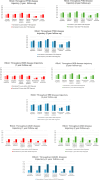Enhancing post-traumatic stress disorder patient assessment: leveraging natural language processing for research of domain criteria identification using electronic medical records
- PMID: 38835009
- PMCID: PMC11151516
- DOI: 10.1186/s12911-024-02554-8
Enhancing post-traumatic stress disorder patient assessment: leveraging natural language processing for research of domain criteria identification using electronic medical records
Abstract
Background: Extracting research of domain criteria (RDoC) from high-risk populations like those with post-traumatic stress disorder (PTSD) is crucial for positive mental health improvements and policy enhancements. The intricacies of collecting, integrating, and effectively leveraging clinical notes for this purpose introduce complexities.
Methods: In our study, we created a natural language processing (NLP) workflow to analyze electronic medical record (EMR) data and identify and extract research of domain criteria using a pre-trained transformer-based natural language model, all-mpnet-base-v2. We subsequently built dictionaries from 100,000 clinical notes and analyzed 5.67 million clinical notes from 38,807 PTSD patients from the University of Pittsburgh Medical Center. Subsequently, we showcased the significance of our approach by extracting and visualizing RDoC information in two use cases: (i) across multiple patient populations and (ii) throughout various disease trajectories.
Results: The sentence transformer model demonstrated high F1 macro scores across all RDoC domains, achieving the highest performance with a cosine similarity threshold value of 0.3. This ensured an F1 score of at least 80% across all RDoC domains. The study revealed consistent reductions in all six RDoC domains among PTSD patients after psychotherapy. We found that 60.6% of PTSD women have at least one abnormal instance of the six RDoC domains as compared to PTSD men (51.3%), with 45.1% of PTSD women with higher levels of sensorimotor disturbances compared to men (41.3%). We also found that 57.3% of PTSD patients have at least one abnormal instance of the six RDoC domains based on our records. Also, veterans had the higher abnormalities of negative and positive valence systems (60% and 51.9% of veterans respectively) compared to non-veterans (59.1% and 49.2% respectively). The domains following first diagnoses of PTSD were associated with heightened cue reactivity to trauma, suicide, alcohol, and substance consumption.
Conclusions: The findings provide initial insights into RDoC functioning in different populations and disease trajectories. Natural language processing proves valuable for capturing real-time, context dependent RDoC instances from extensive clinical notes.
Keywords: Clinical notes; Natural language processing; Post-traumatic stress disorder; Real-world evidence; Research of domain criteria.
© 2024. The Author(s).
Conflict of interest statement
Neal David Ryan is the Treasurer, of the American Academy of Child and Adolescent Psychiatry and also a member of the Scientific Advisory Board of the Child Mind Institute. He reported a financial honorarium from the Scientific Advisory Board of the Child Mind Institute. Thomas R Kosten reports funding from the Department of Defense. LiRong Wang reports a sub-award from the Pharmacotherapies for Alcohol and Substance Use Disorders Alliance (PASA) funded by the Department of Defense. All other authors declare that they do not have any competing interest.
Figures









Update of
-
Enhancing post-traumatic stress disorder patient assessment: Leveraging Natural Language Processing for Research of Domain Criteria Identification using electronic medical records.Res Sq [Preprint]. 2024 Feb 21:rs.3.rs-3973337. doi: 10.21203/rs.3.rs-3973337/v1. Res Sq. 2024. Update in: BMC Med Inform Decis Mak. 2024 Jun 4;24(1):154. doi: 10.1186/s12911-024-02554-8. PMID: 38464073 Free PMC article. Updated. Preprint.
References
-
- Mann SKMR. Posttraumatic Stress Disorder. StatPearls [Internet]. 2023.
MeSH terms
Grants and funding
LinkOut - more resources
Full Text Sources
Medical

